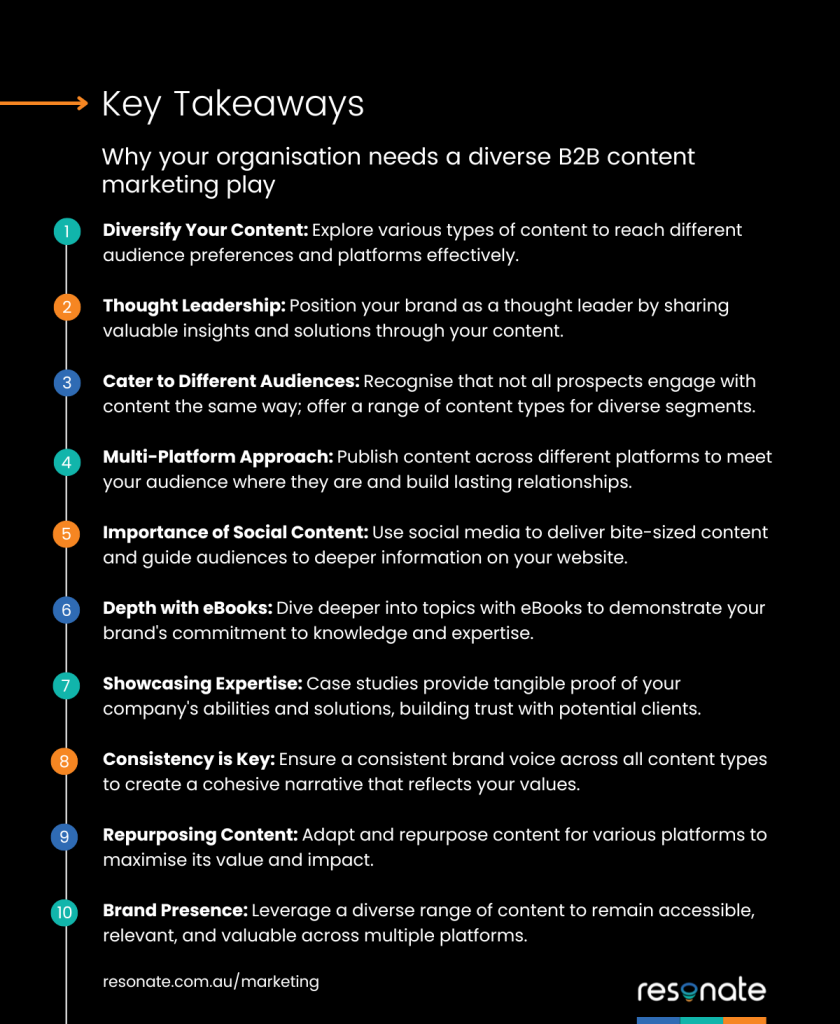B2B content marketing has remained a core part of marketing strategies for many years, connecting brands and their audience. It is more than a method for simply sharing information and ideas; content gives people actionable insights, fosters connections and solidifies your brand’s position as a thought leader.
In my previous blog, I outlined the value of blogging to B2B organisations. In this piece, I will make the case for publishing multiple types of content. It is not enough to simply choose one medium, like only posting on LinkedIn or uploading blogs on your website. You need to publish various types of content to meet your audience where they are and build lasting relationships.

Why do organisations need a diverse array of content?
“Not every prospect engages with content the same way. Embrace variety to cater to diverse audience preferences.”
Your prospects and customers use various platforms when researching a topic, product or brand. They might use LinkedIn while waiting in the coffee line. During their morning commute on the train, they might use Google to delve deeper into a topic by reading a few blogs. For this reason, B2B organisations should publish a diverse array of content.
The more content you have available, the more accessible your brand becomes. Not every prospect will engage with content in the same way. For instance, while some may gravitate towards social media, others might find greater value in an eBook.
Publishing various content types ensures your brand can cater to these varying preferences. Ultimately, ensuring a diverse content strategy is not just about quantity but strategically reaching out to varied audience segments where they are most engaged.
What types of content should you publish?
Blogs
“Blogs position your brand as a thought leader, offering valuable information that reinforces your expertise.”
Blogs primarily focus on discussing industry insights, sharing knowledge and offering solutions to common challenges businesses face. Blogs position your brand as a thought leader within its industry, offering valuable information that educates the reader and reinforces the expertise and reliability of the brand behind the content.
Over time, as readers return to your blog for its insights, they will begin associating your brand with reliability and authority. This builds brand loyalty and can translate into further engagement with your brand and leads for your sales team.
Social content
Social content is an excellent way to deliver short pieces of content and guide audiences to other content on your website. For example, on LinkedIn, you can share 100-word pieces of thought leadership, videos explaining a concept or infographics to break up information. These posts will then include a link to a page on your website where the reader can go further and learn more about your brand.
Social media’s distinct advantage is in concise, bite-sized information for your audience to consume. Due to its shorter form, LinkedIn content takes less time to create than an eBook or blog, enabling you to deliver frequent content to your audience.
eBooks
Unlike blogs that often only have enough space for an overview of a topic, eBooks can dive much deeper. They provide expansive coverage – dissecting a topic layer by layer – giving readers a thorough understanding of the subject matter. An eBook does more than simply share information; it demonstrates your commitment to depth, research, and extensive knowledge in your field.
The true strength of an eBook lies in its dual capacity. It first positions your organisation as a thought leader by providing readers an extensive understanding of a subject. It also offers in-depth content, enabling your brand to present complex ideas or data in an accessible and cohesive format. With structured chapters, good design, and well-crafted narratives, you can present even the most complex subjects in a digestible manner that effectively engages your reader.
Case studies
“Case studies provide tangible proof of your expertise and solutions, making your credibility undeniable.”
A case study covers your work on a project you completed or a solution you delivered to a specific client. It will highlight your client’s situation before your work, how you navigated the project and the outcome.
Case studies are shorter content people can use when deciding whether to work with your company. By offering tangible proof of your company’s expertise and the effectiveness of your solutions, case studies serve as powerful testimonials for potential clients evaluating your credibility and capabilities.
How does this content work together?
“Consistency in brand voice across different content types creates a cohesive narrative that reflects your values.”
When publishing a range of content, you must ensure that your brand’s voice remains consistent. Every article, video, or graphic should not stand in isolation but contribute to a holistic narrative that encapsulates your brand’s message, mission, and values.
One of the benefits of publishing various types of content is adapting and repurposing it for reuse across multiple platforms. For example, you can adapt a blog into a series of blogs, which you can then break down into social posts. This approach not only maximises the value derived from each piece of content but also ensures a consistent and impactful brand presence, regardless of the platform or medium the audience chooses to engage with.
Conclusion
Your audience will use various methods when learning about specific topics or looking into the credibility of your brand. By leveraging a diverse range of content types, your brand can remain relevant, accessible, and top-of-mind across multiple platforms, catering to the diverse preferences of today’s business audience. Each content type caters to different segments and reinforces your brand’s presence and value in the market.

Resonate can build your brand using various types of content
At Resonate, content is one of the core elements of our marketing strategy. We write various types of content designed to target your audience’s pain points, deliver valuable insights, and position you as a thought leader. From social media posts to eBooks, we create content of varying depths to connect you with prospects and your customers. Please visit our Marketing Services page for more on what we offer.
Related blogs
What role does blogging play in B2B lead generation?
Building buyer trust: Use cases and case studies in B2B marketing





